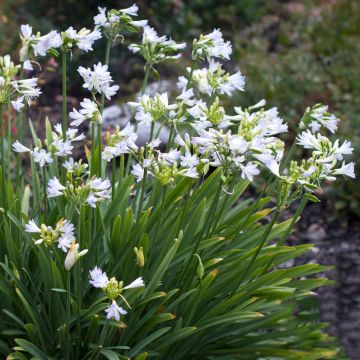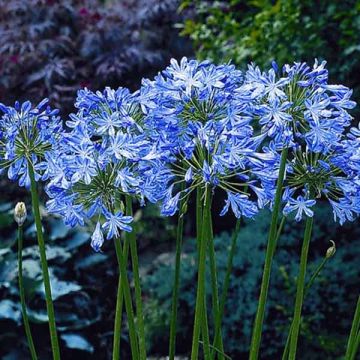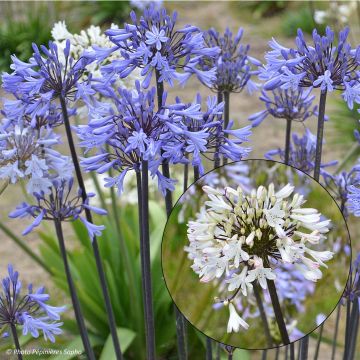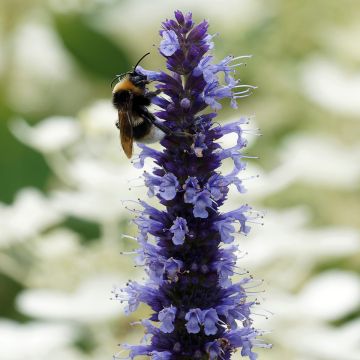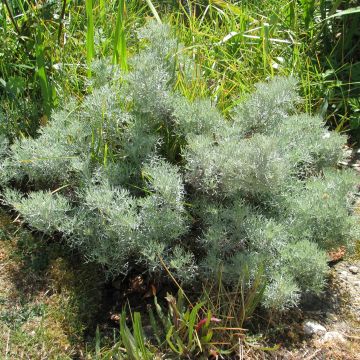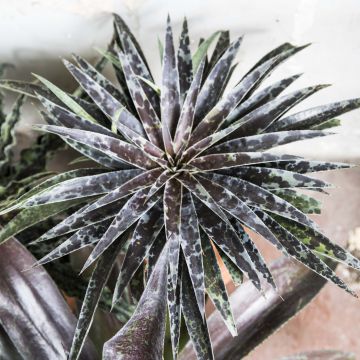

Agapanthe ou agapanthus hybride de Headbourne
Agapanthus Headbourne Blue
Agapanthus Hybride Headbourne Blue
African Lily, Lily of the Nile
This item cannot be shipped to the selected country
Delivery charge from €5.90
More information
Schedule delivery date,
and select date in basket
This plant carries a 12 months recovery warranty
More information
We guarantee the quality of our plants for a full growing cycle, and will replace at our expense any plant that fails to recover under normal climatic and planting conditions.
From €5.90 for pickup delivery and €6.90 for home delivery
Express home delivery from €8.90.
Does this plant fit my garden?
Set up your Plantfit profile →
Description
Agapanthus 'Headbourne' hybrid is undoubtedly the most cold-resistant variety (up to -15°), especially in well-drained soil. It opens its large umbels of intense blue in July/August, from a young age, on a clump of light green ribbon-like foliage, which expands over time. This undemanding plant but with a very exotic appearance is ideal for giving a touch of holidays and seaside to balconies, terraces, and beds. Its faded inflorescences remain decorative on the plant in winter. It is to be grown in full sun, in rich, well-drained, moist to dry soil.
This vigorous and hardy hybrid Agapanthus belongs to the family of Alliaceae (Liliaceae) and descends from various species of South African origin, including Agapanthus campanulatus, which is quite tall and native to the Natal province.
The plant develops in spring from a short rhizome with fleshy roots forming a dense clump of linear, ribbon-like foliage, short, with a minimum diameter of 50cm (20in), expanding over time. Each leaf can reach 40cm (16in) in length and 1cm (1in) in width. When in bloom, it easily reaches a height of 60cm (24in) and a width of 60cm (24in), even more over time. It is in the heart of summer that solid, sturdy floral stems appear, crowned with hemispherical umbels, measuring 12cm (5in) in diameter, with 20 to 50 campanulate flowers of intense medium blue carried by long peduncles. This bulbous plant is hardy up to about -15°C with winter protection, but many specimens have sometimes endured even lower temperatures. The foliage turns yellow and then disappears in autumn.
The hybrid Agapanthus 'Headbourne' is used in the background of beds or to highlight the layout of pathways. It blends well with all types of decor, even the most modern, as long as they are bathed in sunlight. It will be invited in large pots on the terrace, in a pretty wide pottery that will allow this plant to produce numerous flower stalks. This cultivation method has the advantage of being able to store it in winter in a region too cold for it. It is a plant that thrives by the seaside, in an English cottage, and even in a city garden. Cut and placed in a vase, the flowers will bring freshness and a lot of originality to the house. Left in place, the faded inflorescences will decorate the beds asleep in winter.
Report an error about the product description
Agapanthus Headbourne Blue in pictures


Flowering
Foliage
Plant habit
Botanical data
Agapanthus
Hybride
Headbourne Blue
Alliaceae - Liliaceae
African Lily, Lily of the Nile
Cultivar or hybrid
Other Agapanthus - Lily of the Nile
Planting and care
Plant Agapanthus by covering them with at least 10cm (4in) of good soil: this way they will better withstand the cold. It is essential to plant them in spring and mulch them in winter in most of our not-too-cold regions. For pot cultivation, use 5 plants for a 24 cm (9in) pot, and shelter your pots in winter. They prefer a rich and moist but well-drained soil, but they prove resistant to summer drought in deep soil. However, water promotes a beautiful and generous flowering. The presence of limestone in the soil is well tolerated. Water them regularly during the growth period (twice a week). Avoid watering them afterwards. They fear excessive moisture in winter.
Planting period
Intended location
Care
-
, onOrder confirmed
Reply from on Promesse de fleurs
Mediterranean perennials
Haven't found what you were looking for?
Hardiness is the lowest winter temperature a plant can endure without suffering serious damage or even dying. However, hardiness is affected by location (a sheltered area, such as a patio), protection (winter cover) and soil type (hardiness is improved by well-drained soil).

Photo Sharing Terms & Conditions
In order to encourage gardeners to interact and share their experiences, Promesse de fleurs offers various media enabling content to be uploaded onto its Site - in particular via the ‘Photo sharing’ module.
The User agrees to refrain from:
- Posting any content that is illegal, prejudicial, insulting, racist, inciteful to hatred, revisionist, contrary to public decency, that infringes on privacy or on the privacy rights of third parties, in particular the publicity rights of persons and goods, intellectual property rights, or the right to privacy.
- Submitting content on behalf of a third party;
- Impersonate the identity of a third party and/or publish any personal information about a third party;
In general, the User undertakes to refrain from any unethical behaviour.
All Content (in particular text, comments, files, images, photos, videos, creative works, etc.), which may be subject to property or intellectual property rights, image or other private rights, shall remain the property of the User, subject to the limited rights granted by the terms of the licence granted by Promesse de fleurs as stated below. Users are at liberty to publish or not to publish such Content on the Site, notably via the ‘Photo Sharing’ facility, and accept that this Content shall be made public and freely accessible, notably on the Internet.
Users further acknowledge, undertake to have ,and guarantee that they hold all necessary rights and permissions to publish such material on the Site, in particular with regard to the legislation in force pertaining to any privacy, property, intellectual property, image, or contractual rights, or rights of any other nature. By publishing such Content on the Site, Users acknowledge accepting full liability as publishers of the Content within the meaning of the law, and grant Promesse de fleurs, free of charge, an inclusive, worldwide licence for the said Content for the entire duration of its publication, including all reproduction, representation, up/downloading, displaying, performing, transmission, and storage rights.
Users also grant permission for their name to be linked to the Content and accept that this link may not always be made available.
By engaging in posting material, Users consent to their Content becoming automatically accessible on the Internet, in particular on other sites and/or blogs and/or web pages of the Promesse de fleurs site, including in particular social pages and the Promesse de fleurs catalogue.
Users may secure the removal of entrusted content free of charge by issuing a simple request via our contact form.
The flowering period indicated on our website applies to countries and regions located in USDA zone 8 (France, the United Kingdom, Ireland, the Netherlands, etc.)
It will vary according to where you live:
- In zones 9 to 10 (Italy, Spain, Greece, etc.), flowering will occur about 2 to 4 weeks earlier.
- In zones 6 to 7 (Germany, Poland, Slovenia, and lower mountainous regions), flowering will be delayed by 2 to 3 weeks.
- In zone 5 (Central Europe, Scandinavia), blooming will be delayed by 3 to 5 weeks.
In temperate climates, pruning of spring-flowering shrubs (forsythia, spireas, etc.) should be done just after flowering.
Pruning of summer-flowering shrubs (Indian Lilac, Perovskia, etc.) can be done in winter or spring.
In cold regions as well as with frost-sensitive plants, avoid pruning too early when severe frosts may still occur.
The planting period indicated on our website applies to countries and regions located in USDA zone 8 (France, United Kingdom, Ireland, Netherlands).
It will vary according to where you live:
- In Mediterranean zones (Marseille, Madrid, Milan, etc.), autumn and winter are the best planting periods.
- In continental zones (Strasbourg, Munich, Vienna, etc.), delay planting by 2 to 3 weeks in spring and bring it forward by 2 to 4 weeks in autumn.
- In mountainous regions (the Alps, Pyrenees, Carpathians, etc.), it is best to plant in late spring (May-June) or late summer (August-September).
The harvesting period indicated on our website applies to countries and regions in USDA zone 8 (France, England, Ireland, the Netherlands).
In colder areas (Scandinavia, Poland, Austria...) fruit and vegetable harvests are likely to be delayed by 3-4 weeks.
In warmer areas (Italy, Spain, Greece, etc.), harvesting will probably take place earlier, depending on weather conditions.
The sowing periods indicated on our website apply to countries and regions within USDA Zone 8 (France, UK, Ireland, Netherlands).
In colder areas (Scandinavia, Poland, Austria...), delay any outdoor sowing by 3-4 weeks, or sow under glass.
In warmer climes (Italy, Spain, Greece, etc.), bring outdoor sowing forward by a few weeks.



































